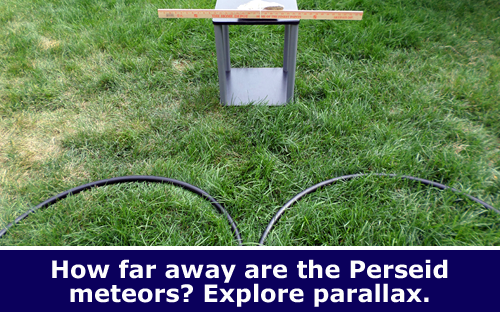Now Playing: The Perseid Meteor Showers
Stay up late, or get up really, really early to catch nature's annual fireworks display. Students and families can extend Perseids fun with a hands-on science exploration of parallax. How far away are the things we see in the sky?
Each August, a much-anticipated nighttime show plays live in our skies: the Perseid meteor showers. This annual event offers you the year's best opportunity to see meteors streaking across the sky, so long as you are willing to be awake well after midnight!
Cosmic Collisions Make for Great Light Shows
Why does the Perseid meteor shower happen each August? Because that's the point in our orbit around the Sun when we are crossing the orbital path of Comet Swift-Tuttle. As Comet Swift-Tuttle travels through space, it leaves behind bits of rock and ice called meteoroids. Some of these fast-travelling meteoroids burn up when they hit Earth's atmosphere. The bright light that we see when this happens is called a meteor. You may have heard some people call these "shooting stars," but meteors aren't stars at all, just burning space debris!
While it is possible to see a meteor on any night, so long as you are looking in the right place at the right time, the Perseids are special because as Earth crosses through the path of Comet Swift-Tuttle, lots of meteors are likely to be visible in the sky, so many that it is called a "meteor shower."
Maximize Your Chances of Seeing a Meteor
Most years, scientists would recommend that you view the Perseids during the "peak" of the showers, which is the time when they expect the most meteors to be visible in the sky. However, this year the moon will be so bright during the expected peak days of August 12 and 13, that scientists are suggesting you head outside in early August.
Your best chance for seeing meteors is in the few hours before dawn, as far away from city lights as possible. Although a blanket or reclining chair will keep you comfortable, the only "tool" that's required is patience. Good things come to those who wait!
Sky Science Connections for Students
Students and families interested in the Perseids, in stargazing, or in astronomy in general can ask space science questions and experiment with Science Buddies astronomy science projects and family science activities.
For example, with a hands-on backyard setup using hula hoops, students (and families) can explore the relationship between the distance of an object and the perspective from which the object is viewed. The way an object appears to move or shift when you look at it from two different positions is known as parallax and is an important concept in understanding how astronomers determine how far away things are in the sky. Both a student science project (suitable for a science fair) and a shorter family science activity are available:
- A Puzzling Parallax (full Science Buddies Project Idea)
- Starry Science: Measure Astronomical Distances Using Parallax (science activity at Scientific American)
These family science experiments don't require the night sky or a telescope, but by exploring parallax, students can better understand how scientists measure how far away things are in the sky.
For more fun family science that connects with this month's Perseids, see Meteor Science: Weekly Science Project Idea and Home Science Activity Spotlight. For added inspiration for student astronomers and space enthusiasts, see the Galactic Curiosity: Fifth Grade Student Charts a Science Course for the Stars student science success story. The Satellite Science: How Does Speed Affect Orbiting Altitude? project idea based on the student's fifth grade astronomy experiment is now part of the Science Buddies directory of free project ideas!
Categories:
You Might Also Enjoy These Related Posts:
- 15 STEM Gifts & Science Kits You'll Feel Good About Giving
- 13 Boat Science and Submarine Science Projects and Experiments
- July 4th STEM! Summer Science Picks for Independence Day!
- 12 Science Kits for Summer Science Experiments and Discovery
- 15 Science Projects to Make and Give for Father's Day
- Ready, Set, Go! (Awesome Summer Science Experiments)
- Awesome Summer Science Experiments
- 10 STEM Activities with Cardboard Tubes










